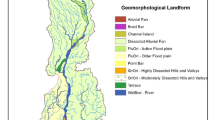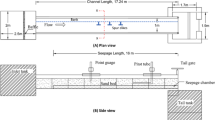Abstract
To estimate discharge through the year (dry season and flood season), a stage–discharge curve derived through monitoring discharge in about 20 rivers or channels every year has been generally used. As revealed in many studies, however, the stage–discharge curve is inevitably affected by their hydraulic characteristics. This suggests that the use of a stage–discharge curve derived without considering hydraulic characteristics unique to a river or channel may produce significant errors in estimating discharge at not only low stage (during dry seasons) but also high stage (during flood seasons). In this study, the authors proposed a method to calculate the mean velocity and to estimate the discharge considering the hydraulic characteristics of a river or channel (e.g. the bed slope, wetted perimeter, width, kinematic viscosity, etc.); the method was developed using Chiu’s velocity equation. With the proposed method, it is possible to calculate a maximum velocity that is difficult to measure in an open channel, derive an entropy function representing the equilibrium of the channel, and thereby, estimate reliable discharge even in a flood season. To comparatively verify the utility of the proposed method, relations between the results of analysis using Manning’s and Chezy’s mean velocity equations and the values of measured discharge were addressed together. The results of analysis using lab data sets and measured data sets revealed that the proposed method was significantly more accurate in estimating discharge, even in flood seasons, when compared with the conventional method.











Similar content being viewed by others
References
Asgeir PØ, Trond R (2009) Accounting for rating curve imprecision in flood frequency analysis using likelihood-based method. J Hydro 366(1–4):89–100
Barton JR, Lin PN (1955) A study of the sediment transport in alluvial channels. Report no. CEF 55JRB2. Colorado State University, Fort Collins, Colorado, p 41
Casey HJ (1935) Uber Geschiebebewegung, Preuss. Versuchsanst. fur Wasserbau und Schifibau, berlin, Mitt., 19:86 (Translation on file at US Soil Conservation Service, Washington, DC)
Chitale SV (1966) Hydraulics of stable channels. In: Tables 13 and 17, Government of India, Ministry of Irrigation and Power, Central Water and Power Commission
Chiu C-L (1978) Three-dimensional open channel flow. J Hydra Divi ASCE 104(8):1119–1136
Chiu C-L (1987) Entropy and probability concepts in Hydraulics. J Hydra Engine ASCE 113(5):583–599
Chiu C-L (1988) Entropy and 2-D velocity distribution in open channels. J Hydra Engine ASCE 114(10):738–756
Chiu C-L (1989) Velocity distribution in open channel flow. J Hydra Engine ASCE 115(5):576–594
Chiu C-L, Chen Y-C (2002) An efficient method of discharge measurement in tidal streams. J Hydro 265:212–224
Chiu C-L, Chiou J-D (1986) Structure of 3-D flow in rectangular open channels. J Hydra Engine ASCE 112(11):1050–1068
Chiu C-L, Tung NC (2002) Maximum and regularities in open-channel flow. J Hydra Engine ASCE 128(4):390–398
Choo TH (2002) Velocity measuring method using the concept of entropy (II): focusing on maximum velocity. J Korean Soc Civil Eng 22(4B):495–515
Choo TH, Kim HS, Kim MS, Kim CG (2000) A study on the stage–discharge relationship in Nakdong Estuary Barrage. In: Proceedings of the Korea Water Resources Association Conference 2000, 535–540
Choo TH, Ok CY, Kim JW, Maeng SJ (2009) A study on the velocity distribution in closed conduit by using the entropy concept. J Korean Soc Civil Eng 29(4B):357–363
Choo TH, Park SK, Lee SJ, Oh RS (2011) Estimation of river discharge using mean velocity equation. KSCE J Civil Eng 15(5):927–938
Colby BR, Hembree CH (1955) Computations of total sediment discharge Niobrara River near Cody, Nebraska. Water-supply Paper 1357, US Geological Survey, Washington, DC
Cunge JA, Holly FM, Verway A Jr (1980) Practical aspects of computational river hydraulics. Pitman, Boston
Davies TR (1971) Summary of experimental data for flume tests over fine sand. Department of Civil Engineering, University of Southampton
Fread DL (1976) A dynamic model of stage–discharge relations affected by changing discharge. NOAA Technical Memorandum NWS HYDRO-16, Office of Hydrology, National Weather Service, Washington, DC
Kim CW, Lee MH, Yoo DH, Jung SW (2008a) Discharge computation in natural rivers using Chiu’s velocity distribution and estimation of maximum velocity. J Korea Water Resour Assoc 41(6):575–585
Kim GH, Park JI, Shin C-K (2008b) Development of rating curves using a maximum likelihood model. J Korean Soc Environ Sanitary Eng 23(4):83–93
Kwon HH, Moon YI, Choi BK, Kim MS (2008) Derivation and uncertainty analysis of rating curve using hierarchical bayesian model. In: Proceedings of the Korea water resources association conference 2008, pp 1211–1214
Lee SJ, Jeong TS (2009) Development of regression equations for the water discharge estimation in tidally affected rivers. KSCE J Civil Eng 13(3):195–203
Leon JG, Calmant S, Seyler F, Bonnet M-P, Cauhopé M, Frappart F, Filizola N, Fraizy P (2006) Rating curves and estimation of average water depth at the upper Negro River based on satellite altimeter data and modeled discharges. J Hydro 328(3–4):481–496
Macleod AB (1997) Development of methods to predict the discharge capacity in model and prototype meandering compound channels. Phd thesis, University of Glasgow, Scotland
Majid R, Mahmoud FM (2006) Prediction of stage–discharge curves in open-channels using a fixed-point velocity measurement. Flow Meas Instrum 17(5):276–281
Rao CR (1965) The theory of least squares when the parameters are stochastic and its application to the analysis of growth curves. Biometrika 52(3):447–458
Sahoo GB, Ray C (2006) Flow forecasting for a Hawaii stream using rating curves and neural networks. J Hydro 317(1–2):63–80
Toffaleti FB (1968) A procedure for computation of the total river sand discharge and detailed distribution. Bed to Surface, Technical Report No. 5, Committee of Channel Stabilization, Corps of Engineers, US Army
Vanoni VA, Hwang LS (1967) Relation between bed forms and friction in streams. J Hydra Div ASCE 93, No. HY3, proc. Paper 5242:121–144
Williams GP (1970) Flume width and water depth effects in sediment transport experiments. US Geological Survey, Professional Paper 562-H
Willis JC (1979) Suspended load from error-function models. J Hydra Div ASCE 105 No. HY7:801–816
Author information
Authors and Affiliations
Corresponding author
Rights and permissions
About this article
Cite this article
Choo, T.H., Yoon, H.C. & Lee, S.J. An estimation of discharge using mean velocity derived through Chiu’s velocity equation. Environ Earth Sci 69, 247–256 (2013). https://doi.org/10.1007/s12665-012-1952-0
Received:
Accepted:
Published:
Issue Date:
DOI: https://doi.org/10.1007/s12665-012-1952-0




